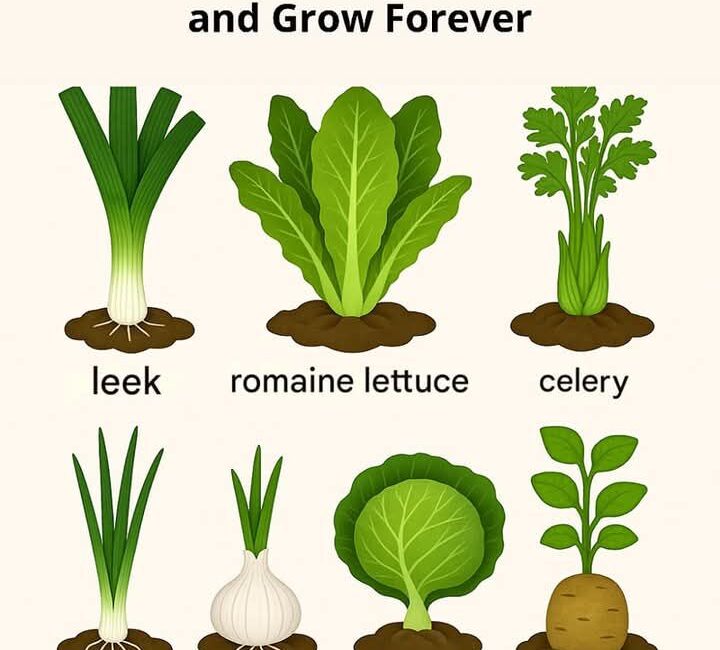- Step-by-Step:
- Separate a garlic bulb into individual cloves, making sure to keep the papery skin on each clove.
- Plant the clove in the soil, with the pointed end facing up and the flat end (where the roots are) facing down.
- Water the garlic regularly, making sure the soil is moist but not waterlogged.
- Over time, the clove will sprout a green shoot. After several months, you’ll have a new garlic bulb ready for harvest.
Growing Tips:
- Garlic needs a long growing season (typically 8-9 months), so make sure to plant it in the fall for a harvest the following summer.
- It’s best to grow garlic in a sunny spot with well-drained soil.
5. Leeks: Regrow from Root Ends
Why Leeks?
Leeks have a mild, onion-like flavor and are fantastic in soups, stews, and salads. Much like green onions, leeks are easy to regrow in water from the root ends.
How to Regrow Leeks:
You can regrow leeks from the root tips, and they will sprout new growth in a matter of weeks.
- Step-by-Step:
- Cut the leek to about 2-3 inches above the root end.
- Place the root end in water, with the roots submerged but the upper part of the leek exposed.
- Put the container in a sunny spot, and within 1-2 weeks, new shoots will begin to appear.
- Change the water every 2-3 days to keep it fresh.
- After the leeks are fully regrown, they can be harvested and used in cooking.
Growing Tips:
- Leeks need plenty of sunlight to grow well, so make sure they are placed in a sunny spot.
- Leeks prefer cooler growing conditions, so be cautious of growing them in excessively warm climates.
6. Basil: Regrow Your Favorite Herb
Why Basil?
Basil is a popular herb known for its aromatic leaves, which are used in countless dishes. What’s great about basil is that it’s incredibly easy to regrow from its stems. Plus, it’s a fast-growing herb that will continuously provide fresh leaves for your meals.
How to Regrow Basil:
To regrow basil, simply take a cutting from an existing plant and place the stem in water until roots form.
- Step-by-Step:
- Cut a healthy basil stem just below a node (where leaves are attached).
- Place the stem in water so that the node is submerged but the leaves are above the waterline.
- Put the glass in a sunny location, and after a few days, you’ll see roots starting to form.
- After about 2 weeks, once the roots are strong enough, transplant the basil into soil or continue growing it in water.
Growing Tips:
- Basil loves sunlight, so place it in a bright, sunny spot.
- If growing in soil, make sure the basil gets plenty of water but avoid over-watering, which can lead to root rot.
7. Potatoes: Regrow from Eyes and Cuttings
Why Potatoes?
Potatoes are one of the easiest vegetables to regrow from leftovers. Simply cut a potato into sections, each containing an “eye” (the small sprouts on the skin of the potato), and plant them in the soil.
How to Regrow Potatoes:
Potatoes grow back when planted from their “eyes,” which are the small buds on the potato skin. These eyes will sprout new potatoes if given the right care.
- Step-by-Step:
- Cut a potato into sections, making sure each piece has at least one eye.
- Let the potato pieces dry for a few days to form a protective callus over the cut edges.
- Plant the pieces in soil, with the eyes facing up.
- Water regularly and keep the soil loose and well-drained.
- After a few months, new potatoes will begin to grow, and you can harvest them once they’re ready.
Growing Tips:
- Potatoes need plenty of space to grow, so make sure to plant them in a large container or garden bed.
- They prefer cooler weather, so plant them in the early spring for a summer harvest.
Conclusion: A Sustainable Way to Grow Your Own Food
Growing your own food, even in small spaces, has never been easier. With these seven vegetables, you can buy them once and keep regrowing them indefinitely. Not only does this save you money, but it also reduces food waste and ensures that you always have access to fresh, nutritious produce. Whether you have a spacious backyard or just a small windowsill, you can start regrowing your vegetables today and enjoy the satisfaction of growing your own food sustainably.
By following the steps outlined for each vegetable, you’ll be on your way to creating a continuous cycle of fresh produce right at your fingertips. Happy gardening!




